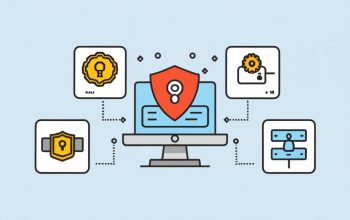As cryptocurrencies ascend in value and adoption, concomitant expansion of fraud and cybercrime has yielded billions in stolen digital assets annually. From devious social engineers to sophisticated hackers, the crypto landscape finds no shortage of bandits eager to separate naive investors from precious holdings. Effectively combatting this emerging “crime of the future” necessitates vigilance and resilience across people, processes and technologies constituting the cryptocurrency ownership lifecycle. This guide explores best practices for minimizing attack surfaces, detecting threats early and responding promptly across the critical elements placing assets at risk – private keys, wallets, exchanges and blockchains. Arm yourself with rigorous preventative measures to shield your hard-earned portfolio gains over the long run.
Introduction to Cryptocurrency Crime Prevention
Security vulnerabilities have long plagued cryptocurrencies, but headline-grabbing exchange breaches and high profile fraud incidents have elevated comprehension of long underappreciated risks requiring diligent management for investors. Billions in crypto have been pilfered through: careless password practices enabling credential theft, lax wallet and exchange protections susceptible to hacking and long con confidence schemes psychologically manipulating undiscerning victims. As expanding adoption spotlights cybersecurity weaknesses, prioritizing resilience against crypto-specific threats protects portfolios from avoidable loss at the hands of digital banditry.
Understanding Cryptocurrency Wallets
Cryptocurrency wallets house the public and private keypairs enabling participation on blockchain networks:
Public keys – Like bank account numbers, they enable receiving transfers by sharing openly.
Private keys – Allow spending funds with account holder authentication guaranteed cryptographically when initiating outward payments.
Wallets come in various forms with their own security considerations:
Software wallets – Apps like MetaMask facilitate transactions but connectivity risks malware infection which can capture keys and seed phrases in transit or storage.
Hardware wallets – Devices such as Ledger and Trezor enable secure offline private key storage beyond the reach of internet attacks targeting online systems. But hardware integrity and PIN code leaks still pose risks requiring controls.
Paper wallets – Keys generated and printed on paper introduce another offline storage mechanism. However, creating them on compromised machines can potentially expose keys to capture during process.
Securing private keys appropriately remains imperative for preventing unauthorized transfers by attackers. Password hygiene and controlled, regular asset movement into offline environments helps thwart theft opportunities.
Password Guidelines for Cryptocurrency
The first barrier preventing cryptocurrency account access starts with a strong password for securing private keys and wallet seed phrases resisting guessing and brute force attempts. Consider these tips in crafting suitable passwords:
Randomness – Incorporate computer-generated randomness without linkage to any personal reference points hackers may research or guess through social engineering. Avoid sequences, keyboard patterns and date associations.
Length – Longer is stronger to frustrate brute forcing attempts. 12 characters only takes days to crack while 20+ characters with added spaces substantially escalates difficulty requiring years.
Variation – Unique passwords across accounts prevent breaches from spreadingSITE phishing tricks users into surrendering credentials, malware captures them outright and subtle exploits drain funds absent vigilance.
Managing password security hygienically offers a vital barrier preventing unauthorized account access leading to asset drainage.
Two-Factor Authentication for Cryptocurrency
While strong master passwords provide baseline account security, two-factor authentication (2FA) enables enhanced protection by necessitating providing two forms of identity verification when accessing accounts:
Proof of identity – Via password knowledge
Verification of possession – Through unique codes sent to a designated mobile device or hardware security key ownership validating identity.
With two discrete factors needing confirmation in tandem from the authorized user, 2FA blocks phishing schemes reliant solely on pilfered passwords and presents a second obstacle for hackers to overcome. Activate 2FA universally across wallets, accounts and crypto platforms to bolster safety.
Best Practices for Storing Cryptocurrency
When not actively trading, prudent risk management dictates safeguarding cryptocurrency holdings offline in “cold” hardware or paper wallets beyond the reach of internet assaults targeting “hot” online environments like exchanges. Primary cold storage mechanisms carry specific usage procedures:
Hardware Wallets
Devices like Ledger and Trezor enable offline private key storage and transaction signing for robust air-gapped security. Strict hardware wallet PIN code and passphrase confidentiality remains imperative if devices get lost or damaged. Update firmware regularly and purchase directly from manufacturers to prevent tampering.
Paper Wallets
Printed QR codes and private keys enable DIY cold storage if generated properly on secure, disconnected machines only. Treat completed documents discretely like cash in flameproof envelopes or safe deposit boxes. Properly made paper wallets offer highly durable offline security.
Custodial Cold Storage
Reputable cryptocurrency custodians like Gemini build institutional-grade infrastructure incorporating multilayer offline security exceedingly difficult for individuals to replicate alone. However, dependence on third parties assuming control over assets carries inherent risks of malfeasance as well requiring extensive due diligence. Tread carefully.
Storing holdings predominantly offline substantially reduces attack vectors which online-only assets remain perpetually exposed to.
Cryptocurrency Security Risks and Threats
Managed judiciously using distributed blockchain ledgers, cryptocurrency protocols have proven impressively resilient. However lingering vulnerabilities in supporting access technologies like wallets and exchanges leave assets jeopardized by various attack vectors:
Keylogging malware – Insidious infections secretly record wallet activity and passwords entered locally while also altering clipboards and addresses during transfers enabling theft. Isolate cryptocurrency computing using only trusted machines while leveraging hardware wallets and antivirus tools.
SIM swapping – Attackers socially engineer mobile providers to improperly transfer numbers to their devices gaining 2FA access allowing account drainage. Restrict changes carefully when selecting carriers while limiting SMS authentication.
Phishing links – Fake emails and websites trick users into inputting wallet credentials landing directly into attacker possession. Analyze links extremely carefully and avoid entering data anywhere except official avenues specifically used before.
Exchange breaches – Despite extensive security investments, hot exchanges still suffer recurring compromises losing billions in customer funds historically. Only keep active trading minimums present on exchanges while backing up most assets offline externally.
With crypto’s increasing pervasiveness comes widening attack scalability. Prioritize risk management methodically across accounts, devices and platforms holding keys to your kingdom of digital riches.
Cryptocurrency Security Tools and Services
Security-enhancing tools provide additional layers of protection:
Antivirus and anti-malware software – Essential for detecting infections and questionable network traffic indicating credential-seeking malware. Tools like HitmanPro specialize in behavior analytics. Update virus definitions automatically.
Virtual Private Networks (VPN) – Encrypt Internet connections while accessing online accounts or transmitting transaction commands to fortify data like private keys from snooping or manipulation.
Email protection filters – Services like AnonAddy generate alias email addresses hiding actual accounts from phishing schemes enabling safe link clicking for true messages.
Asset Recovery Services – New offerings like Coinfirm and Asset Reality track stolen crypto transfers seeking legal interventions if funds route through regulated exchanges. Improves recovery odds post-breach.
Monitoring Services – Platforms like Rand Labs notify customers of transactions linked to their assets alerting about suspicious activities like phishing originations warranting prompt intervention.
Regularly evaluating and integrating new countermeasures maintains vigilance and preparedness improving incident response effectiveness.
Cryptocurrency Security Regulations and Compliance
Cryptocurrency governance remains limited currently to anti-money laundering (AML) “Know Your Customer” (KYC) requirements and sanctions screening mandated for accountable transactions. Wallets and exchanges must verify user identities under these measures. Further security regulations likely including:
Standardized custodial qualifications – Benchmarking asset safekeeping protocols and infrastructure protections across institutional capital investments
Mandatory insurance coverage requirements – Requiring participant pools guaranteeing financial compensations against certain fraud or theft loss scenarios
Increased exchange liability – Heightened legal repercussions for exchange cyber breaches through stricter liability standards
Security auditing requirements – Requiring periodic penetration testing evaluating infrastructure vulnerabilities with mandated remediation
Regulatory oversight aims to add stability toward legitimizing cryptocurrency within mainstream finance. Expect more balanced guardrails ahead not stifling innovation.
Institutional Cryptocurrency Security and Crime Prevention
Large asset managers, hedge funds, pension programs and insurance firms incorporating crypto require customized security fitting expanded threat landscapes:
External custody – Specialist providers like BitGo incorporate necessary cold storage, insurance coverage, reporting audit trails and access control mechanisms meeting institutional expectations.
Incident response planning – Documented incident response plans speed coordination with legal authorities and forensic firms when breach events inevitably occur to limit financial/reputational damage.
Staff vetting – Avoiding “inside jobs” requires vetting authorized signers on custodied assets to uncover money laundering offenses or conditions attractive for recruitment by organized crime seeking infiltration.
Transaction controls – Multiparty transaction authorization introducing oversight for fund movements provides checks against unauthorized insider activities across custodial accounts.
Program audits – Scheduled technical evaluations by reputable firms like Trail of Bits pressure test security protocols and infrastructure configurations uncovering gaps. Changes get made proactively rather than retroactively.
Institutions build in-house teams specialized in crypto-assets for tailored risk assessment, monitoring and security management aligned to holding values.
Individual Investor Cryptocurrency Security
While safeguarding billions in assets requires expansive resources, simple security tenets apply for individual crypto investors guarding against fraud schemes and cybercriminals targeting access points like private keys, devices and accounts:
Master password hygiene – Enable password manager apps with strong multifactor authentication to generate, store and fill distinct high complexity account passphrases frustrating guessing attempts.
Phone lockdown – Only permit SIM card swap authorization in-person with ID verification at mobile carrier stores after establishing a password. Get alerted to unauthorized changes.
Update religiously – Maintain current firmware and software across devices maximizing vulnerability remediation from continuous patches addressing publicly disclosed exploits before criminals weaponize them.
Multi-signature approvals – Require multiple sign-offs activating asset transactions enhancing oversight for changes. Added protections defend against device compromise or user imposters.
Monitor accounts closely – Watch account activity consistently through native block explorer transaction feeds eyeing unusual originations potentially indicative of credential compromise warranting prompt freeze and remediation.
Cold storage backups – Significant holdings deserve the additional security of storage mechanisms like hardware wallets kept offline without connectivity reducing attack surfaces for compromise via hot wallets.
With expanding crypto adoption comes widening attack scalability. Carelessness gets exploited – so prioritize personal risk management methodically.
Cryptocurrency Security and Taxes
Maintaining thorough cryptocurrency transaction records enables accurate capital gains and loss harvesting for tax reporting filings. However losing wallet keys or exchange account access often makes historical activity permanently irrecoverable – while still leaving filers liable for taxes theoretically owed. This demands implementing resilient data retention protocols no matter what security breaches happen. Remotely backing up transaction histories also unlocks informed tax planning opportunities instead of reactive payments at year-end. Don’t let poor security protocols create tax headaches.
Conclusion: Committing to Crypto Protection Across All Layers
Revolutionary blockchain networks supporting cryptocurrencies contain proven security innovations. However ongoing headlines of major fraud and theft incidents spotlight lingering vulnerabilities requiring vigilant management across ancillary crypto access layers like private keys, devices, accounts and platforms jeopardizing assets. Combatting digital banditry targeting these weak links demands methodically instituting best practices around robust access controls, multi-channel monitoring, updated hardware, threat intelligence tracking, cold storage, insurance safeguards and timely incident response. In parallel, allow legal authorities expanding jurisdictional powers to appropriately counteract speculative crypto crime waves still outpacing outdated legislation. Protecting your apportioned slice of economic history requires proactively securing the keys to the cryptocurrency kingdom across all dimensions through a combination of individual vigilance and collective deterrence.
Frequently Asked Questions
What are the biggest cryptocurrency threat vectors currently?
Phishing to steal access credentials, SIM swapping for account takeover and malware installing keyloggers or backdoors pose the largest cryptocurrency fraud threats now by enabling unauthorized asset transfers from wallets and exchanges.
What’s the most secure way to store cryptocurrency holdings?
Hardware wallets and properly generated paper wallets kept completely offline (“in cold storage”) provide the most secure storage mechanisms currently by removing exposure to internet-based attack vectors targeting online “hot” wallets.
Can lost or stolen cryptocurrency be recovered?
Recovering pilfered cryptocurrency remains very rare since blockchains immutably record transactions in perpetuity usually landing in anonymizing mixers shortly after theft. But asset recovery services like Coinfirm track transfers seeking legal interdiction if funds route through regulated off-ramps before laundering.
How can cryptocurrency investors avoid theft or fraud incidents?
Methodically safeguarding private keys by using hardware wallets, maintaining device security through patching and malware protection, activating account alerts and monitoring transaction activity offers the strongest fraud prevention. Backup assets kept offline provide contingency protection as well.
Does cryptocurrency security compliance reduce fraud risks?
Requirements like mandatory Know Your Customer identity checks, custodial financial reporting, investor insurance coverage pools and increased platform security liabilities aim to legitimize markets by expanding protections against fraud vulnerabilities undermining mainstream adoption presently. Accountability drives change.
Who bears the responsibility for securing cryptocurrency assets?
As decentralized networks, securing cryptocurrency assets ultimately falls upon owners themselves since no central authority oversees participation or protections. This makes rigorously implementing fraud prevention best practices essential for investors and traders alongside properly backing up account access credentials held privately.
Tommy Prat is a blockchain developer who is passionate about the technology's potential to revolutionize the world. He has been involved in several successful cryptocurrency projects, and he is excited to see how blockchain can be used to create trustless systems that improve transparency and efficiency. Tommy is also an avid martial artist, and he enjoys practicing Brazilian jiu-jitsu in his free time.



